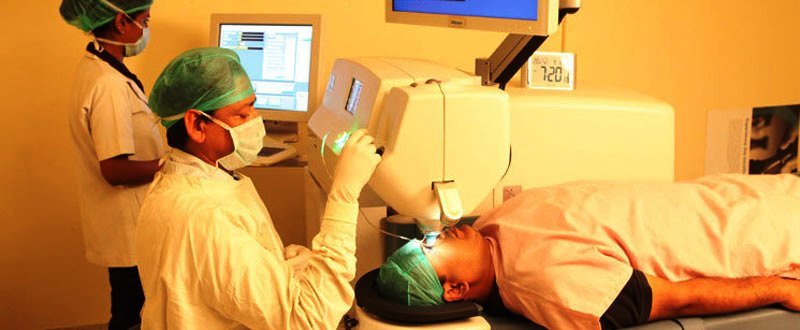If your doctor has mentioned that you need phacoemulsification or “phaco”, chances are you have been diagnosed with cataract.
Phacoemulsification means emulsification or liquefaction of the natural lens of the eye, and is derived from the Greek word for the lens, “phakos”. It is the latest cataract surgery technique which involves state of the art technology and makes cataract surgery a safe and effective surgical procedure.
Phacoemulsification was first introduced by Kelman in 1967 and revolutionized the management of cataract and visual rehabilitation in the years to come. The techniques and results of cataract surgery have undergone a sea change during the past few decades, with smaller incisions and foldable lenses being implanted through them becoming more the norm than the exception.
In fact, most of the cataract surgeries performed in the world today, use this surgical technique with excellent visual outcomes, patient safety, and efficacy.
What happens during Phacoemulsification surgery?
- Two small incisions, around 2mm in length, are made in the clear cornea, the clear part of the eye, where it meets the white portion of the eye, called sclera.
- A bent needle is then introduced into the front compartment of the eye, called anterior chamber and a circular opening is created on the lens surface or anterior capsule.
- A small pen-like instrument (phaco probe) which is powered by ultrasonic energy is inserted into the eye.
- Sound waves or high-frequency ultrasound waves then are used to break the cataract into small pieces by the process of emulsification.
- The liquefied pieces of the cataractous lens pieces are then sucked out from the eye by the process of irrigation and aspiration.
- In this process, the posterior capsule of the lens remains intact, forming the scaffolding on which the artificial intraocular lens or IOL is placed.
- An intraocular lens implant is placed inside the lens capsular bag, which is constituted by the posterior capsule and the remnants of the anterior capsule in which the circular opening was initially made.
- Foldable intraocular lenses and other premium IOLs that are currently in use significantly shorten the time for visual recovery.
- The corneal incisions are self-sealing because of their wound architecture and usually do not require stitches or sutures.
- The entire surgery is usually carried with the patient awake and breathing without assistance. The anesthesia used is usually eye drops, called local anesthesia, or an injection in the eye area, depending on patient preference and doctor’s choice.
Why is it preferred over conventional cataract surgery?
- The conventional extracapsular cataract surgery incision measures around 11mm and requires multiple stitches for closure. These may require a suture removal at a later date.
- The circular opening of the anterior lens capsule as compared to the irregular opening in conventional cataract surgery results in greater stability of the IOL.
- The incidence of surgically induced corneal astigmatism is less with phacoemulsification, resulting in less dependence on glasses after the surgery.
- The faster and less complicated surgery means that the patient spends less time in the hospital during and after surgery, and reduces the economic burden of the patients, due to the rapid recovery of visual function in cataract patients. These patients can, therefore, return to work earlier.
- Incidence of potentially serious sight-threatening complications like vitreous loss, cystoid macular edema, wound leak, retinal detachment and endophthalmitis are less, thereby increasing the safety and efficacy of the cataract surgery procedure.
What are the advantages?
Phacoemulsification has fast become established as the gold standard for cataract surgery for the following reasons:
- The most important advantage, of course, is visual rehabilitation. The vision is often better than ever before since the IOL implanted in the eye compensates for the earlier refractive error and patients can choose to have special lenses that can correct for distance alone (monofocal lenses), near and distance both (multifocal lenses) and even astigmatism (toric lenses).
- Small incisions which usually do not require stitches or sutures.
- Better vision results in more confidence, better mobility, and
- Another psychological impact is the enormous relief from the fear of blindness. Most patients report a feeling of bright and clear vision, knowing that their worries were hitherto irrational.
- Since the surgical downtime is not significant, most patients find it easy to resume their usual activities within two to three days of surgery including TV watching, reading and resuming official duties also.
What are the disadvantages?
The disadvantages of the technique are few and related mostly to the cost of the machine and instrumentation. In poorly developed countries that usually is the biggest barrier to its adoption. The main disadvantages of phacoemulsification include:
- Expensive devices and instruments may be a deterrent in certain underdeveloped parts of the world
- One time use only, disposable equipment adds to cost of surgery
- Lack of surgical skill and training as well as hands-on experience in several medical schools
- Higher incidence of surgical complications like corneal damage in unskilled hands in comparison to conventional cataract surgery
- Requires a cooperative patient who will not move the head during operation, making it less preferable in certain patients
If the phacoemulsification technique is expensive for you, choose from other cataract surgery options which are listed at https://www.eye7.in/cataract-surgery/.
What is critical for surgical outcomes when undergoing Phacoemulsification?
- Eye status: The primary determinant of surgical success is your eye health. In the absence of any other eye diseases like corneal opacity and diseases, retinal disorders like age-related macular degeneration, glaucoma, , the prognosis of cataract surgery is excellent. Preexisting refractive errors can usually be compensated for by choosing the appropriate lens implant.
- Surgeon: Choosing the right surgeon is critical to success of the operation since his or her expertise in the surgical technique determines the visual outcomes of cataract surgery. Phacoemulsification is a highly sophisticated procedure that is dependent on surgical skill and prowess of the individual doctor. It is also essential to choose a doctor with whom you can strike a rapport, and who is easy to talk. A communicative, pleasant ophthalmologist will explain the risks and benefits of surgery, and help you make an informed decision about your eye health and visual needs.
- Technique and lenses: The choice of surgical procedure is determined by a thorough eye examination by the doctor, and also patient preference. Premium IOLs are usually associated with better visual results since they provide better optics, minimize optical aberrations and compensate for all refractive errors, including astigmatism.
- Hospital: Choosing the right facility is crucial since it determines the operation theatre and maintenance of asepsis which is critical in ensuring protection from infections. The right patient experience in pleasant surroundings is vital to your feeling of well-being.






